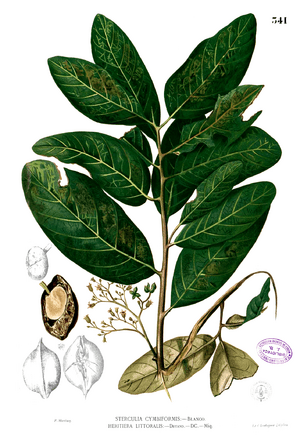Looking-glass mangrove facts for kids
Quick facts for kids Looking-glass mangrove |
|
|---|---|
 |
|
| Conservation status | |
| Scientific classification | |
| Genus: |
Heritiera
|
| Species: |
littoralis
|
| Synonyms | |
|
|
The looking-glass mangrove, also known as Heritiera littoralis, is a large tree. It gets its name because the underside of its leaves looks shiny and silvery, like a mirror or a looking-glass! The top of the leaves is green, but if you flip them over, they look white because of tiny, silvery scales.
This tree has special wing-shaped nuts. You can usually find the looking-glass mangrove growing along the seashores in places like Bangladesh, the Indian Subcontinent, Southeast Asia, and tropical Africa. Its strong wood has been used for a long time to build boats. The fruits of this tree are called dungon in some places and are even used in Philippine cooking for a dish called kinilaw.
Contents
What's in a Name? Common Names for the Looking-Glass Mangrove
The looking-glass mangrove has many different names around the world! Here are some of them:
- Bengali – sundari (সুন্দরী) (সুন্দরি)
- Bahasa Indonesia – dungun kecil, dungun laut
- Filipino - dungon
- Hindi – sundari (सुंदरी)
- Japanese – sakishimasuōnoki (サキシマスオウノキ)
- Malay – pokok dungun
- Sinhala – etuna (ඇටුන) / ho mediriya (හෝ මැදිරිය)
- Tongan – mamaea
- Vietnamese – cui biển
- Visayan – dungon
- Maldivian – ކަހަރުވައް (kaharuvah)
- Chamorro - ufa
How People Use the Looking-Glass Mangrove
The looking-glass mangrove is a very useful tree! People harvest its wood because it is known for being super tough and lasting a long time. It can even stand up to saltwater, which is why it's great for building things near the ocean.
Building with Strong Wood
Because its wood is so strong and durable, the looking-glass mangrove is often used for:
- Building boats
- Making pilings (strong poles driven into the ground to support structures)
- Constructing bridges
- Building wharves (platforms built out over water for boats to dock)
A Special Ingredient in Filipino Cooking
The fruits of trees in the Heritiera family, including the looking-glass mangrove, are used in Philippine cooking. They have a special job: they help to take away the "fishy" taste from kinilaw. This is a local dish made from raw fish mixed with vinegar or citrus juices. Another tree whose fruits are used in a similar way is the tabon-tabon tree (Atuna racemosa).
Gallery
See also
 In Spanish: Taloto de Filipinas para niños
In Spanish: Taloto de Filipinas para niños






